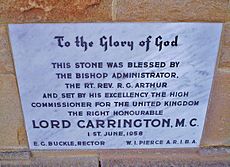Peter Carington, 6th Baron Carrington facts for kids
Quick facts for kids
The Lord Carrington
|
|||||||||||||||||||||||||||||||||||||||||||||||||||||||||||||||||||||||||||||||||||||||||||||||||||||||
|---|---|---|---|---|---|---|---|---|---|---|---|---|---|---|---|---|---|---|---|---|---|---|---|---|---|---|---|---|---|---|---|---|---|---|---|---|---|---|---|---|---|---|---|---|---|---|---|---|---|---|---|---|---|---|---|---|---|---|---|---|---|---|---|---|---|---|---|---|---|---|---|---|---|---|---|---|---|---|---|---|---|---|---|---|---|---|---|---|---|---|---|---|---|---|---|---|---|---|---|---|---|---|---|
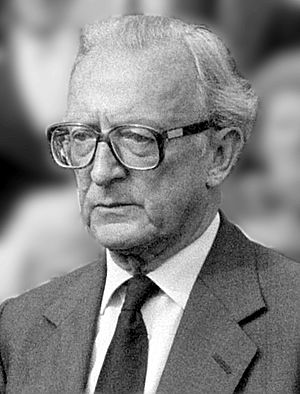
Carrington in 1984
|
|||||||||||||||||||||||||||||||||||||||||||||||||||||||||||||||||||||||||||||||||||||||||||||||||||||||
| 6th Secretary General of NATO | |||||||||||||||||||||||||||||||||||||||||||||||||||||||||||||||||||||||||||||||||||||||||||||||||||||||
| In office 25 June 1984 – 1 July 1988 |
|||||||||||||||||||||||||||||||||||||||||||||||||||||||||||||||||||||||||||||||||||||||||||||||||||||||
| Preceded by | Joseph Luns | ||||||||||||||||||||||||||||||||||||||||||||||||||||||||||||||||||||||||||||||||||||||||||||||||||||||
| Succeeded by | Manfred Wörner | ||||||||||||||||||||||||||||||||||||||||||||||||||||||||||||||||||||||||||||||||||||||||||||||||||||||
| Secretary of State for Foreign and Commonwealth Affairs | |||||||||||||||||||||||||||||||||||||||||||||||||||||||||||||||||||||||||||||||||||||||||||||||||||||||
| In office 4 May 1979 – 5 April 1982 |
|||||||||||||||||||||||||||||||||||||||||||||||||||||||||||||||||||||||||||||||||||||||||||||||||||||||
| Prime Minister | Margaret Thatcher | ||||||||||||||||||||||||||||||||||||||||||||||||||||||||||||||||||||||||||||||||||||||||||||||||||||||
| Preceded by | David Owen | ||||||||||||||||||||||||||||||||||||||||||||||||||||||||||||||||||||||||||||||||||||||||||||||||||||||
| Succeeded by | Francis Pym | ||||||||||||||||||||||||||||||||||||||||||||||||||||||||||||||||||||||||||||||||||||||||||||||||||||||
|
|||||||||||||||||||||||||||||||||||||||||||||||||||||||||||||||||||||||||||||||||||||||||||||||||||||||
| Member of the House of Lords | |||||||||||||||||||||||||||||||||||||||||||||||||||||||||||||||||||||||||||||||||||||||||||||||||||||||
| Hereditary peerage 6 June 1940 – 11 November 1999 |
|||||||||||||||||||||||||||||||||||||||||||||||||||||||||||||||||||||||||||||||||||||||||||||||||||||||
| Preceded by | The 5th Baron Carrington | ||||||||||||||||||||||||||||||||||||||||||||||||||||||||||||||||||||||||||||||||||||||||||||||||||||||
| Succeeded by | Seat abolished | ||||||||||||||||||||||||||||||||||||||||||||||||||||||||||||||||||||||||||||||||||||||||||||||||||||||
| Life peerage 17 November 1999 – 9 July 2018 |
|||||||||||||||||||||||||||||||||||||||||||||||||||||||||||||||||||||||||||||||||||||||||||||||||||||||
| Personal details | |||||||||||||||||||||||||||||||||||||||||||||||||||||||||||||||||||||||||||||||||||||||||||||||||||||||
| Born |
Peter Alexander Rupert Carington
6 June 1919 London, England |
||||||||||||||||||||||||||||||||||||||||||||||||||||||||||||||||||||||||||||||||||||||||||||||||||||||
| Died | 9 July 2018 (aged 99) Bledlow, England |
||||||||||||||||||||||||||||||||||||||||||||||||||||||||||||||||||||||||||||||||||||||||||||||||||||||
| Political party | Conservative | ||||||||||||||||||||||||||||||||||||||||||||||||||||||||||||||||||||||||||||||||||||||||||||||||||||||
| Spouse |
Iona McClean
(m. 1942; died 2009) |
||||||||||||||||||||||||||||||||||||||||||||||||||||||||||||||||||||||||||||||||||||||||||||||||||||||
| Children | 3, including Rupert | ||||||||||||||||||||||||||||||||||||||||||||||||||||||||||||||||||||||||||||||||||||||||||||||||||||||
| Parent |
|
||||||||||||||||||||||||||||||||||||||||||||||||||||||||||||||||||||||||||||||||||||||||||||||||||||||
| Alma mater | Royal Military College, Sandhurst | ||||||||||||||||||||||||||||||||||||||||||||||||||||||||||||||||||||||||||||||||||||||||||||||||||||||
| Military service | |||||||||||||||||||||||||||||||||||||||||||||||||||||||||||||||||||||||||||||||||||||||||||||||||||||||
| Allegiance | United Kingdom | ||||||||||||||||||||||||||||||||||||||||||||||||||||||||||||||||||||||||||||||||||||||||||||||||||||||
| Branch/service | |||||||||||||||||||||||||||||||||||||||||||||||||||||||||||||||||||||||||||||||||||||||||||||||||||||||
| Years of service | 1939–1949 (inactive from 1945) | ||||||||||||||||||||||||||||||||||||||||||||||||||||||||||||||||||||||||||||||||||||||||||||||||||||||
| Rank | Major | ||||||||||||||||||||||||||||||||||||||||||||||||||||||||||||||||||||||||||||||||||||||||||||||||||||||
| Unit | Grenadier Guards | ||||||||||||||||||||||||||||||||||||||||||||||||||||||||||||||||||||||||||||||||||||||||||||||||||||||
| Battles/wars | Second World War | ||||||||||||||||||||||||||||||||||||||||||||||||||||||||||||||||||||||||||||||||||||||||||||||||||||||
| Awards | Military Cross | ||||||||||||||||||||||||||||||||||||||||||||||||||||||||||||||||||||||||||||||||||||||||||||||||||||||
Peter Alexander Rupert Carington, 6th Baron Carrington, Baron Carington of Upton (born June 6, 1919 – died July 9, 2018) was an important British politician. He was a member of the Conservative Party. He held many high-level jobs in the government.
Carrington was the Defence Secretary from 1970 to 1974. He was also the Foreign Secretary from 1979 to 1982. Later, he became the Secretary General of NATO, which is a big international organization. This was from 1984 to 1988.
One of his biggest achievements was helping to end a conflict in Rhodesia. This led to the creation of Zimbabwe. He did this by leading talks for the Lancaster House Agreement.
In 1982, when Argentina invaded the Falkland Islands, Carrington was the Foreign Secretary. He took responsibility for not seeing this coming and resigned from his job. As NATO Secretary General, he helped stop a war between Greece and Turkey in 1987.
After a law changed in 1999, hereditary peers (people who inherit their title) could no longer automatically sit in the House of Lords. So, Carrington was given a new title, Baron Carington of Upton, which allowed him to stay in the House of Lords.
Contents
Early Life and Family History
Peter Alexander Rupert Carington was born in Chelsea, London, on June 6, 1919. He was the only son of the 5th Baron Carrington. His family had a long history with the title "Baron Carrington."
He grew up at Millaton House in Devon. He went to two private schools: Sandroyd School and Eton College.
Military Service in World War II
Carrington trained at the Royal Military College, Sandhurst. He joined the Grenadier Guards as a second lieutenant in 1939. He fought in the Second World War.
He was a tank commander during Operation Market Garden in 1944. He led the first tanks to cross the Nijmegen railway bridge in the Netherlands. For his bravery, he received the Military Cross in 1945. He stayed in the army until 1949.
Political Career: Serving the UK
In 1938, Peter Carrington became the 6th Baron Carrington. He joined the House of Lords in 1945 after the war. He then started his political career.
Early Government Roles
Carrington served in the Conservative governments led by Winston Churchill and Anthony Eden.
- From 1951 to 1954, he was a secretary for the Minister of Agriculture and Food.
- From 1954 to 1956, he was a secretary for the Minister of Defence.
- In 1956, he became the High Commissioner to Australia. This meant he was Britain's top diplomat there until 1959.
Leading Roles in the 1960s and 1970s
After returning to Britain, he served under Prime Minister Harold Macmillan.
- From 1959 to 1963, he was the First Lord of the Admiralty. This was a top job in the Royal Navy.
- From 1963 to 1964, he was a Minister without Portfolio and Leader of the House of Lords. This meant he led the government's business in the House of Lords.
When the Conservative Party was not in power (1964-1970 and 1974-1979), he was the Leader of the Opposition in the House of Lords.
When the Conservatives returned to power in 1970 under Edward Heath, Carrington became Defence Secretary. He held this role until 1974. He also served as the Chairman of the Conservative Party from 1972 to 1974. For a short time in 1974, he was also the Secretary of State for Energy.
Foreign Secretary and the Falklands War
In 1979, Margaret Thatcher became Prime Minister. She made Carrington her Foreign Secretary. Thatcher thought highly of him.
Carrington led important talks in 1979 called the Lancaster House conference. These talks helped end a war in Rhodesia and led to the country becoming Zimbabwe.
In 1982, Argentina invaded the Falkland Islands. As Foreign Secretary, Carrington felt responsible for this event. He resigned from his position on April 5, 1982. This was a big moment in British politics.
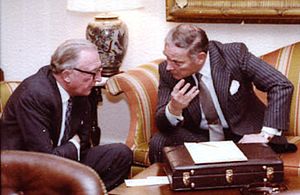
Later Career and Public Service
After leaving the Foreign Office, Lord Carrington continued his public service.
Secretary General of NATO
From 1984 to 1988, he served as the Secretary General of NATO. NATO is a military alliance of many countries. In this role, he helped prevent a conflict between Greece and Turkey in 1987.
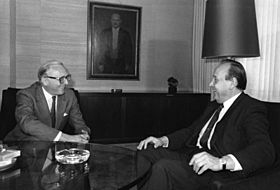
Other Important Roles
- In 1991, he led diplomatic talks about the breakup of Yugoslavia. He tried to create a plan for peace.
- He was the Chancellor of the University of Reading.
- He chaired the Bilderberg conferences from 1990 to 1998.
- He was the President of the Britain–Australia Society for many years.
- He was also the Chancellor of the Order of the Garter, a very old and important British order of chivalry, from 1994 to 2012.
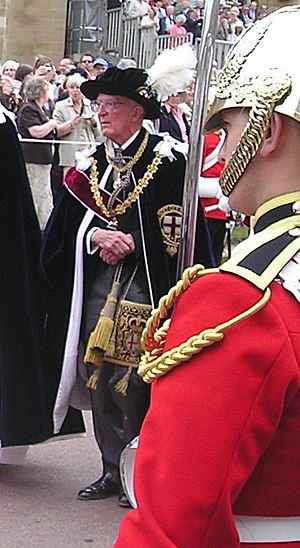
Final Years and Legacy
After the House of Lords Act 1999, Lord Carrington was given a new title, Baron Carington of Upton. This allowed him to continue serving in the House of Lords. He was the longest-serving member of the House of Lords for a time.
Lord Carrington passed away on July 9, 2018, at the age of 99. He died at his home in Bledlow, Buckinghamshire. His son, Rupert, became the 7th Baron Carrington. A memorial service was held for him at Westminster Abbey in 2019.
Family Life
Lord Carrington married Iona McClean in 1942. They were married for 67 years until she passed away in 2009. They had three children:
- Alexandra de Bunsen (born 1943)
- Virginia Carington (born 1946)
- Rupert Carington (born 1948)
Honours and Awards
Peter Carrington received many honours for his service:
- 1945: Military Cross (for bravery in battle)
- 1958: Knight Commander of the Most Distinguished Order of St Michael and St George (KCMG)
- 1959: Member of Her Majesty's Most Honourable Privy Council
- 1983: Companion of the Order of the Companions of Honour (CH)
- 1985: Knight Companion of the Most Noble Order of the Garter (KG)
- 1988: Knight Grand Cross of the Most Distinguished Order of St Michael and St George (GCMG)
- 1999: Life peerage, as Baron Carington of Upton
- 1988: Presidential Medal of Freedom (from the United States)
- Freedom of the City of London
See also
 In Spanish: Peter Carington para niños
In Spanish: Peter Carington para niños


